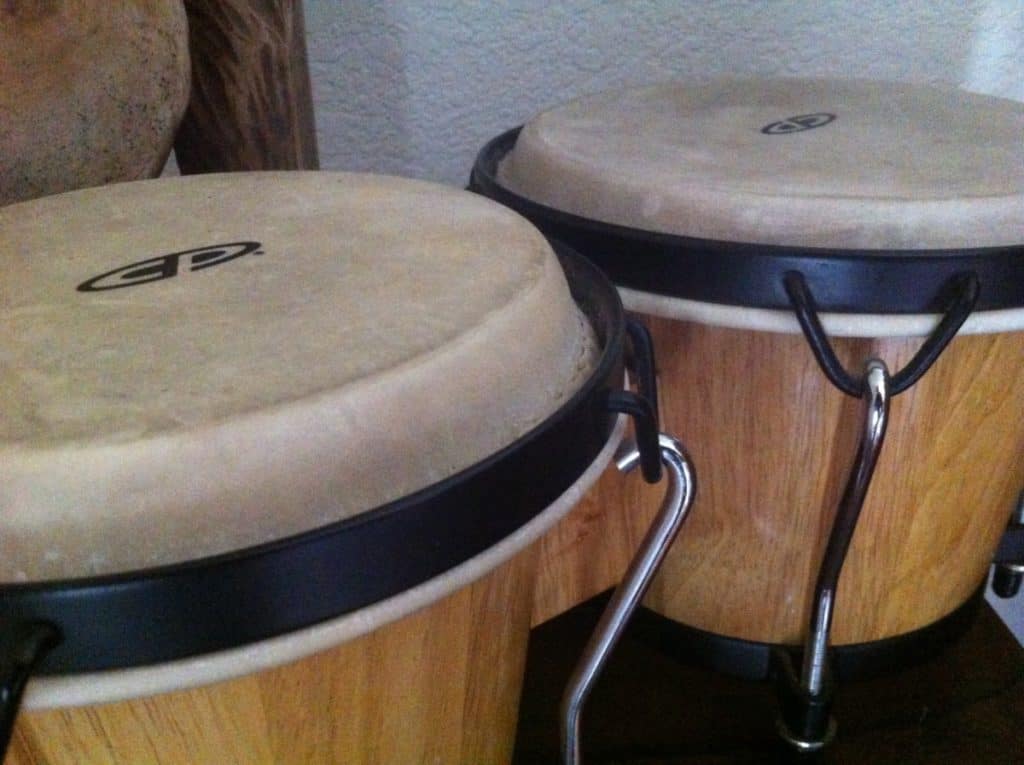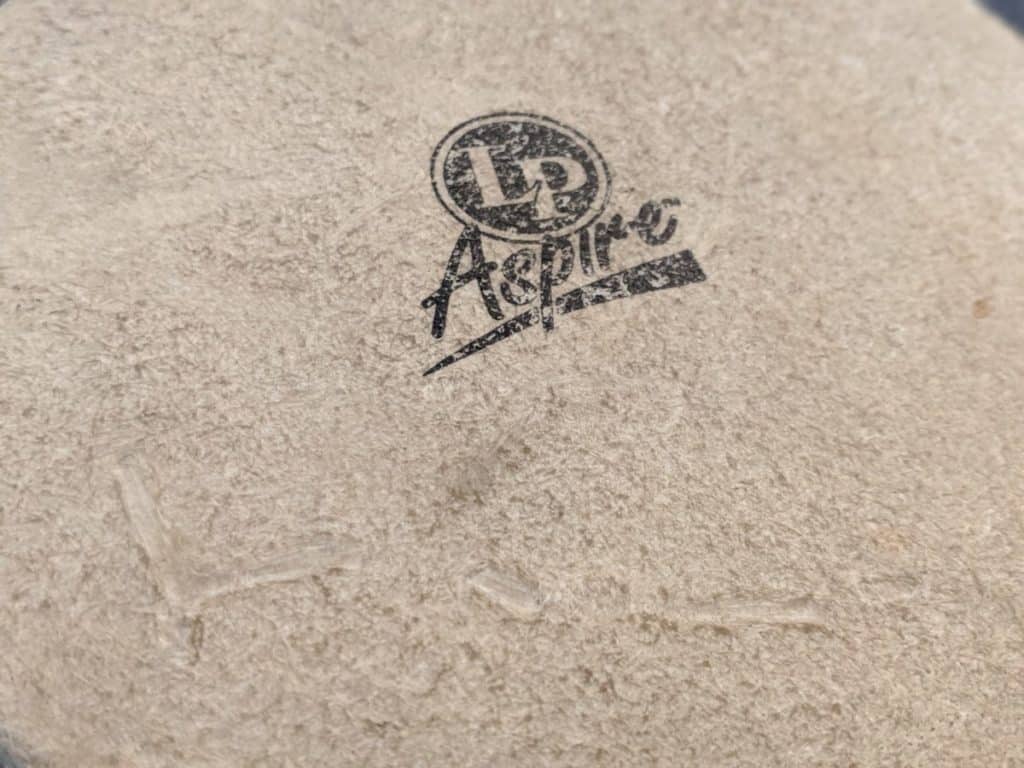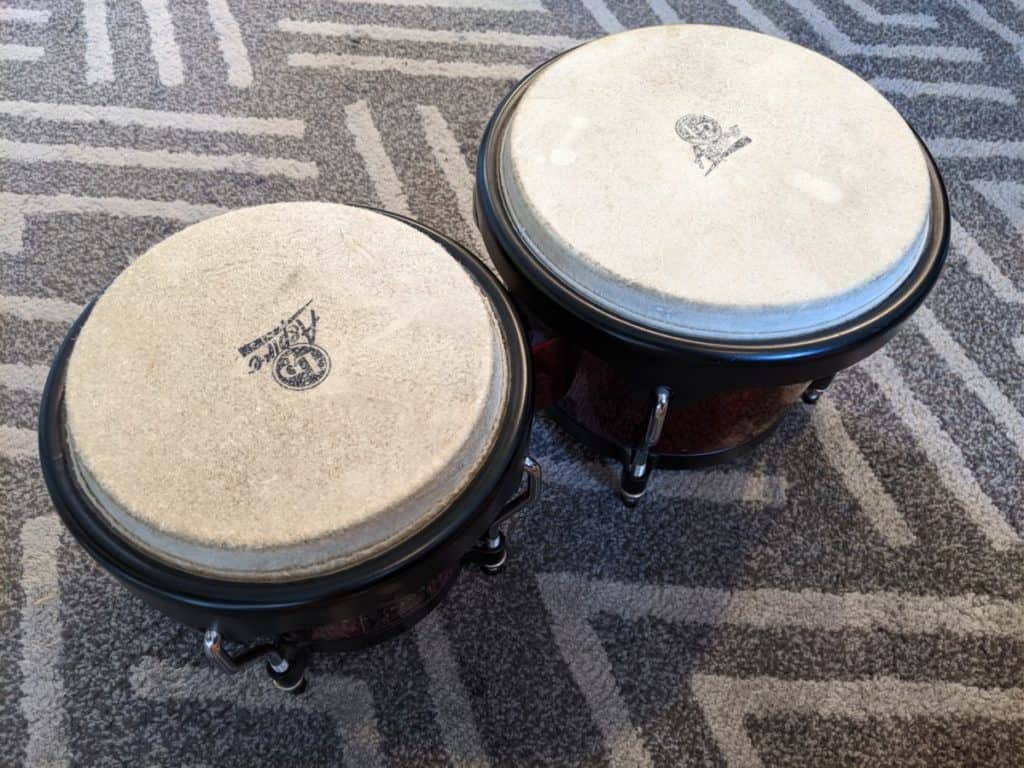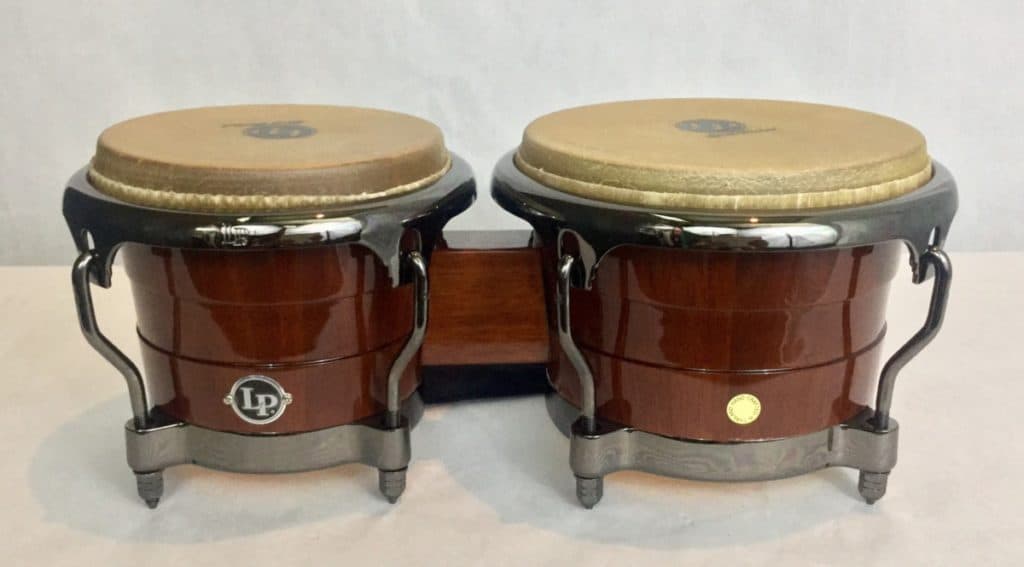This post contains affiliate links. We earn commissions if you purchase products from retailers after clicking on a link from our site. As an Amazon Associate, we earn from qualifying purchases.
So you want to buy some bongos but are not sure what price point makes sense. I also wanted to know what’s the difference between cheap, mid-grade, and expensive bongos, so I decided to do the research and share it here.
Bongo drums will fall in the following price ranges:
| Quality | Used | New |
| Entry-Level | $25-$50 | $40-$90 |
| Enthusiast | $40-$100 | $90-$200 |
| Professional | $100-$300 | $200-$500 |
By the way, looking for recording equipment and musical instruments? Check out Sweetwater.com for microphones, monitors, audio interface or any other recording gear that you could ever need. (Affiliate Link)
So, that’s nice, isn’t it? All these bongo drums from $25 all the way to $500. What’s the difference between all of them? Is it worth spending the extra money for the higher-end bongo drums? Are the entry-level bongos worth anything?
Let’s dive in and see what features the different price ranges offer.
Entry-Level Bongo Drum Prices and Characteristics
I’m a huge fan of not getting the most pricey instrument until you’re sure that you’re ready to pursue the instrument in earnest. There is a balance, though.

Getting the cheapest instrument may not serve you well, because sometimes the cheapest instrument may not be as fun. I can attest to the truth of this… I’ve played some guitars while I was learning guitar where it wasn’t fun because the guitar sounded so bad and went out of tune so fast.
The place to aim for is where you strike a balance and get an instrument in the middle or near the top of the entry-level price range. At this spot, you can get a feel for the instrument and get a good idea if you want to pursue the instrument without spending your inheritance.
When I say entry-level, I am talking about bongos that are not toys and can be tuned. There are all sorts of novelty or “vintage” bongos that cannot be tuned that I’m not including in my analysis here.
List of Entry-level Bongo Characteristics
- Less-expensive shell materials: Rubberwood (Siam Oak), plywood, plastic (ABS)
- Poorer Sound Quality (this is truly up to your own ear, but read on to see and hear a comparison)
- Thicker Drumheads
- Cheaper hardware, potentially more difficult to tune, and potentially may not stay in tune.
- More paint, less varnish
Less-Expensive Shell Materials
The shell of the bongos are the main body of the bongo drums and are most often made of wood, but can be made of plastic or even other materials. The shell can make a big difference in your sound since the shell resonates as you strike the drumhead. The drumhead and its tension is what makes the majority of the sound, but the shell itself contributes enough to make a difference.
The ideal is for the wood to be joined as tightly together as possible forming one piece (a bongo isn’t a hollowed out stump, they are formed by gluing vertical strips together to make a continuous cylinder).
Siam Oak is a popular construction material for inexpensive all the way to mid-range bongos (and sometimes professional), and it can make a decent sound. Siam Oak isn’t like an oak tree that you may be familiar with–it refers to a rubberwood, so it is softer than a typical oak. Siam oak is far less expensive than Mahogany or other hardwoods.
It’s arguable that the cheaper materials for the shell contribute to a poorer sound in less expensive bongos. The thing is that a drum is a drum and it really is up to your track and your own preferences what constitutes a good sound.
Furthermore, because the wood isn’t always the most high quality, you’ll probably see more efforts to cover up the wood with paint in favor of varnish. This isn’t a bad thing–inexpensive bongos can look very nice, but you can definitely tell the difference visually between higher quality bongos and entry-level.
Thicker Drumheads
From my research, I noticed that the inexpensive bongos have very thick drumheads.
Here is an example of Toca’s entry-level bongos called their Synergy series:
Two things to notice, first, that the drums sound pretty flat. I admit this is subjective, and there are a number of variables contributing to that–but just know that is the kind of sound these entry-level bongos have.
Second, If you notice, the drumheads show no transparency and are practically opaque. This means the drumheads are quite thick.
Although this doesn’t cause too many difficulties learning the bongos, thicker drumheads are more difficult to play–you have to apply more pressure to make the same amount of sound as thinner drumheads.
Additionally, many bongoceros prefer thinner drumheads, at least for one of their bongo drums (some actually prefer to have the thicker drumhead on the hembra).
Fortunately, you can always replace your drumheads if you don’t like the ones you have or if they get damaged, so this isn’t a dealbreaker.
Cheaper Hardware
This will vary from brand to brand and model to model, but generally, the highest quality materials aren’t used for the tuning lugs. The best tuning lugs can be tuned without unnecessary friction.
Carefully oiling your hardware can help any issues you may have. Just know that you may have a different experience tuning with the least expensive bongos vs. other price points.
Examples of Entry-Level Bongos
Drum manufacturers usually have several different models and several of these models are entry-level. The most telling way to know if bongos are entry-level are not is price. Generally, entry-level bongos can be found from $40 to $90 new.
- CP Traditional Bongos (LP’s Website)
- Toca Synergy Series Bongos (Musician’s Friend)
- Meinl Headliner Series Bongos (Musician’s Friend)
- LP City Series Bongos (LP’s Website)
Enthusiast-Level Bongo Drum Prices and Characteristics
If you have had bongos, played bongos, or perhaps want to buy a set of bongos you are okay growing into, then the enthusiast price range will work well for you. The range can be from $90 to $200.
Many of these bongos can even work for recording or jams, even if they aren’t the highest possible quality and price.
Furthermore, bongos in this price range have a durability that will keep you playing for years.
Case in point, I’ve had my LP Aspire bongos for over 15 years. The hardware and drumheads have stood the test of time… that goes to show that I haven’t played them consistently–I’m sure if I did that I would have had to replace the drumheads several times.

List of Enthusiast-Level Bongo Characteristics
- Mid-Quality Shell materials (almost always Siam Oak), often with decorative grooves, sometimes with thicker wood
- Thinner drumheads
- Chrome hardware and rims
- Decent build and construction
Enthusiast-Level Bongo Quality
The most important difference between entry-level bongos and enthusiast-level bongos is the build quality. Although the type of materials are often very similar–for example, Siam oak is not considered a premium wood, necessarily, and it is used in entry-level bongos all the way up to professional-level bongos.

However, the thickness of the wood and the quality of the construction still play a large role in the overall quality of the bongos. If the shells are not glued together meticulously, or if the wood is low quality or thin, it can impact the sound (probably only nominally) as well as how long the bongos hold together.
In summary, bongos in the enthusiast-level price range will generally have a more solid construction.
Enthusiast-Level Bongo Drumheads
this is where you will start to see bongo drumheads of a higher quality. Instead of being opaque, you’ll start to see drumheads that are slightly transparent. Often you’ll find bongos that come with animal skins in this price category.
Are synthetic drumheads and animal-skin drumheads worse or better quality?
It’s often up to personal preference–many bongoseros say they can feel and hear a difference. The animal-skin drumhead being more warp, and the synthetic drumheads being more sharp.
Again, you can modify the experience of your bongo drums dramatically if you change the drumheads. The thickness of the drumhead makes a big difference.
Free-Ride Suspension
Starting in the enthusiast-level price range, you will see bongo drums with different suspension systems. One example is the Meinl’s Free Ride suspension system. Bongos are typically connected via metal hardware, and some argue that the tone of the bongos is affected by metal being drilled into the side of the bongo shell.
Free Ride suspension effectively connects the two bongos without this hardware–allowing for presumably a better tone. Specifically, the resonance of the bongos is impacted. If you’d like to learn more about resonance in bongo drums, check out our article about how bongos make sound here.
Examples of Enthusiast-Level Bongos
- The LP Aspire Series, including the L601-AW (LP’s Website)
- The LP Matador Series, including the M301, and the M201-AWC (LP’s Website)
- Meinl Free Ride Series including the FWB190 (Musician’s Friend)
Professional Bongo Drum Prices and Characteristics
You’ve arrived. You can now consider yourself a bongosero. You’ve played for a some years and you’ve spent the time to master the rhythms and techniques of a true bongo player.

A professional-level set of bongos can be found anywhere from $200 to $500. The price range completely depends on the degree of customization. Toca, for example, makes several bongo drum series that are custom to famous percussionists. The more custom your bongos, the higher the price.
Furthermore, often bongo professionals will fit and use their own drumheads to match their style of playing, which adds to the cost (not as much as you would think, though.
List of Professional-Level Bongo Drum Characteristics
- Expensive shell materials: Ash, Oak, Mahogony, Cherry Eucalyptus, (sometimes Siam Oak)
- Non-generic animals skins: Water Buffalo, calfskin, etc. (in other words, they start to advertise what animal skin type it is in this price range. Not always, though.)
- High quality and beautiful finishes. No doubt, the most expensive bongos look very nice
- Custom Builds
- Stainless Steel hardware, sometimes with gold finishes and other fancy touches like that. In any case, you’re all but guaranteed a consistent tuning experience and bongos that will stay in tune
Professional-Level Bongo Quality
To be fair, the quality for professional-level bongo quality won’t be as remarkable as the difference between entry-level and enthusiast-level. However, it’s at this price point where you start to see bongos of premium wood, with customized paints and varnishes to accommodate the tastes of the bongosero.
Mahogany, Red Oak, and other premium woods are seen here. Even Siam Oak is still around, but the build quality is superior.
Examples of Professional-Level Bongos
- LP’s Original Bongo Series (that’s right, just called “LP” —LP’s website)
- LP Giovanni Galaxy Series (Musician’s Friend)
- Pearl Elite Bongos (X8Drums website)
- Tycoon Percussion Bongos (TSBP-800BC, Amazon)
What Price Point is Right for Me?
The answer is it depends, honestly. If you are completely unsure if you are really serious about getting into the bongos, or if you want to buy bongos for a child, then the entry-level price point is a fantastic place to start.
If you don’t know how to play bongos but are looking for a rewarding instrument that is accessible to many, but you don’t want to get the cheapest out there and want something that will last, then the enthusiast price point is a great way to go. If you played percussion in high school and just want some bongos around for your own jam sessions, again, the enthusiast price-range is a great place to start.
I’m a little biased, since most of my bongo experience has been with my LP Aspire bongos. They are at the bottom of the enthusiast-level price range, but as I’ve said, I’ve had these bongos for over 15 years with the original drumheads. LP makes quality drums and these drums sound great.
If you are serious about playing the bongos and have been playing for a couple years, than you might start thinking about the professional-level price point for bongos. Your bongos are going to sound great and look amazing. The professional-level price point is definitely overkill if you are planning to only occasionally play the bongos. They definitely are worth it, though if you plan to record songs or regularly perform.
How Can I Upgrade My Bongos?
The easiest way to upgrade your bongos and take them to the next level is to change your drumheads. The thinner the drumhead, the more “pop” you get and the easier it is to make the same level of sound. You don’t have to strike the drum as hard.
Changing your drumheads is a process. Your first task is to find the drumheads you want. Fur and Hide is an online company that specializes in selling drum rounds that can be used for bongos or congas or other drums.
Additionally, you can find synthetic drumheads with the thickness you want with Remo or another drumhead manufacturer.
How Can I Get More Bongo For My Buck?
You can save almost 50% of the original bongo price by buying used. My light perusal on eBay turned up a remarkable number of options for professional-level bongos for around or less than $150. Buying used is always a risk, but you could get bongos for much cheaper that will work great for you.
If you want to know more about animal skins vs. synthetic, as well as step-by-step instructions on how to change your bongo drumheads, check out our article here.
